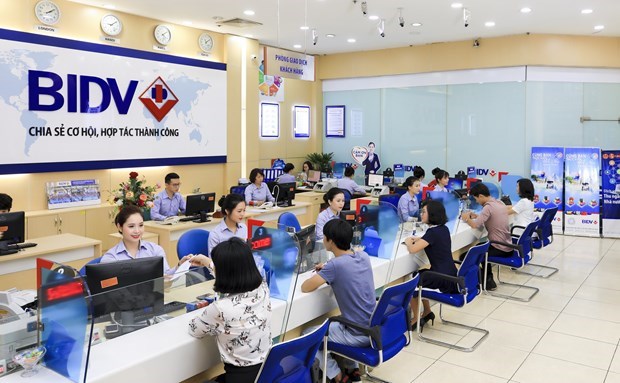Inadequate regulations hinder green credit growth
Green credit growth in Vietnam has remained limited due to the lack of a clear legal framework, according to industry insiders.
 Customers make transactions at a BIDV office. To promote green credit, it is necessary to have an effective coordination policy to help projects obtain green certifications. (Photo: VNA)
Customers make transactions at a BIDV office. To promote green credit, it is necessary to have an effective coordination policy to help projects obtain green certifications. (Photo: VNA)Data from the State Bank of Vietnam (SBV)’s Credit Department for Economic Sectors showed as of December 31, 2022, the outstanding loans for green projects increased by 12.96% against the end of 2021 to more than 500 trillion VND, accounting for more than 4.2% of the total outstanding loans of the whole economy. The loans mainly focused on green agriculture, renewable energy, and clean energy.
Nguyen Thi Phuong, Deputy General Director of Agribank, said though Agribank has set aside a large amount of capital for green credit, it is not easy to disburse.
In many areas around the country, it is easy to find out a clean agricultural model or a commodity production model, but it is very difficult to find out a green model, which has to meet many criteria and certifications, Phuong explained.
In recent years, green credit in Vietnam has grown strongly, but banking expert Can Van Luc said green outstanding loans are still modest compared to the total outstanding loans of the whole banking system.
To promote green credit, Phuong said it is necessary to have an effective coordination policy to help projects obtain green certifications.
The Vietnam Business Forum’s Banking Working Group (BWG) recommends Vietnam needs a roadmap to quickly apply green energy and an appropriate green financial framework for projects that can get bank loans through actions such as the development of the transitional financial instruments, the preparation of environmental-social-governance (ESG) reports and the investment portfolio transformation.
Commercial banks hope the Government will promote the development of green credit by issuing more detailed guidance on the definition of ‘green’ and assessment criteria.
To promote green credit, some banks have recently built a sustainable loan framework with a green credit appraisal process. For example, State-owned BIDV, which topped the market in green credit with a total committed capital of more than 2.68 billion USD by the end of 2022, last month issued the sustainable loan framework to ease the green loans.
State-owned Agribank has also issued a series of documents on promoting green credit growth, and environmental and social risk management in credit granting activities.
Besides State-owned banks, some private banks have also joined the green credit segment, but the disbursement amount was not much as they are still concerned about long repayment period, large investment costs and high market risks of green projects, including renewable energy ones./.













